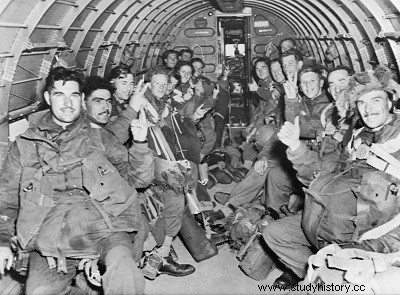
Montgomery then devised his plan. It was a question of blasting the crust of the German cover by means of a series of airborne operations. By seizing the successive bridges which lie between the Dutch frontier and the Rhine (see map), he hoped to be able to clear the way for a rapid advance of the Second Army across Holland towards the plains of northern Germany, thus avoiding the problems posed by the crossing of the Rhine and the Meuse and overflowing the works of the Siegfried line which ended in the forest region of the Reichswald.
It was not the first time that Montgomery suggested to General Omar Bradley, commander of the XII American Army Group, that they unite their efforts to constitute a compact mass of 40 divisions which nothing more could resist in his advance to the northeast.
But for political and military reasons, Eisenhower refused to be
convinced. While acknowledging the value of a push north which would provide a good seaport to supply a final action towards the Ruhr, he considered it inappropriate to stop General Patton whose Third Army was advancing south satisfactorily. The Rhine. he said, we would reach it with all the allied forces; as for the later offensives, it was necessary, before thinking about it. having solved the problems posed by supplies and the arrival of reinforcements. »
However, Eisenhower was prepared to give Montgomery some priority. for the prerequisite for the success of any invasion of Germany was the free disposal of the Channel ports and Antwerp. had just been created under the command of American General Brereton.
It was early September, the amazing Allied advance had just come to a halt, and Montgomery felt the time had come to appeal to airborne troops.
The bridges to be captured were five in number, two of which were over canals. It was the Wilhelmine Canal (about forty kilometers beyond the Dutch border) and the Zuid Willems Vaart (fifteen kilometers further north). The other three bridges were over the Meuse, the Waal and the Neder Rijn (Lower Rhine). A division of the airborne army was to be placed in the 30 kilometer interval which separates Eindhoven from Uden with the mission of seizing the two bridges over the canals and opening the road which joins them. A second division would target the bridges over the Meuse at Grave and over the Waal at Nijmegen. Finally, a third, parachuted in Arnhem, would be responsible for guaranteeing the passage of the Neder Rijn which, at this point, is 150 meters wide.
Ambitious, of course, the plan did not lack imagination. If successful, the benefits to the Allies would be substantial. Not only would the Siegfried Line be outflanked, but an excellent starting base towards Germany would be obtained at the same time as the German forces in Holland would be surrounded as soon as the army had reached the Zuiderzee.
Naturally, the plan had its opponents. General Bradley spoke with disdain of this "salient secondary road" to reach the Reich and worried about the dangerous gap it would create between the 2nd and 1st armies. As for General Dempsey, whose intelligence services reported increasing German activity in Holland, particularly in the Arnhem and Nijmegen region, he thought it best to strike a blow in the American sector, to the east, in the direction of the Rhine, at Wesel, rather than "going off by the tangent" in Holland alone.
On September 10, Dempsey came to see Montgomery to defend his point of view. But Montgomery replied that he had just received a message from London asking what could be done to neutralize the V2 launch bases in the Hague area (on September 8, two days earlier, the first V2 fell on London). There was no more discussion possible:we would attack in the north.
At least Dempsey could be happy about one aspect of the deal. The route that his army would follow was so unpredictable that the enemy would certainly be the first to be surprised! On the other hand, airborne operations would thus take place at a reasonable distance from British bases.
Eisenhower, too, was reluctant at first. Montgomery's plan assumed that transport aviation would be diverted from its essential supply mission. He was to write later:
It was difficult to determine exactly whether it was more advantageous to keep the air force in its supply mission. But one thing was certain:the fact of modifying the use of the planes would force the airborne operation to be delayed for several days in order to be able to prepare equipment and crews for their new mission.
However, he refused categorically to give the airborne operation and the maneuver to the north absolute priority over the action of Patton who, in fact, was extending his front to the south and was on the eve of linking up with the troops of the VI ° American army group, which was coming up from the Mediterranean.
